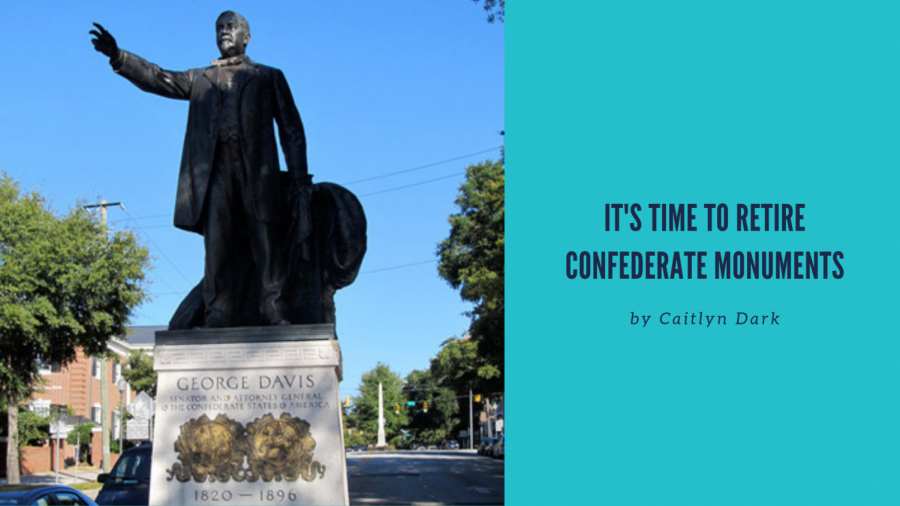It’s time to retire Confederate monuments
Natasha Smith
The George Davis Monument in Wilmington, NC, a tribute to the fourth Attorney General of the Confederate States
Standing proudly over the intersection of Market and 3rd is a bronze statue of George Davis, former senator and the fourth — and final — attorney general of the Confederate States of America.
Unveiled in 1911 by the Daughters of the Confederacy, the statue honoring the Wilmington native was but one statue raised in the wave of hundreds across the country — and especially the former Confederate South — popping up in sync with the new Jim Crow laws that legalized racial segregation and discrimination at the turn of the 20th century. While the 1896 case of Plessy v. Ferguson said “separate but equal,” the appearance of these statues made it clear that things were anything but equal.
Much like UNC Chapel Hill’s Confederate Monument, also known as “Silent Sam,” which was placed on campus in 1913 and torn down during protests in late 2018, George Davis’ statue was not really meant to honor the Confederate dead. Rather, these statues were meant as a public way for the post-war South to continue exerting power over the black population and reinforce white supremacy.
By reasserting these symbols of the pro-slavery fight, especially in predominantly black neighborhoods and towns being ruled by Jim Crow laws, the ruling white majority could continue to assert power over black people long after slavery was no longer the law of the land. The statues served the purpose of reminding the black communities just where the ruling whites stood: they were but the next generation of the confederacy and they would return to the dehumanizing system of slavery in a heartbeat.
In fact, these statues cannot count as true public art to begin with; these statues were shoddily made en masse in Northern workshops and were hastily installed in their Southern locations. That’s why there are so many of them, and why any time protesters manage to pull one of them down, they go without much of a fight. Silent Sam bowed after a couple protesters looped ropes around him and tugged, his visage crumpling as it hit the ground. In contrast, protesters pulling down statues in other situations are often only successful if there’s a huge crowd helping to topple the statue or they have use of heavy equipment.
Now, I’m not saying we should just throw them all away — as someone who has worked an internship at the Bellamy Mansion Museum, I know the importance of conserving history, even the darker and more unsavory parts. But what we should do is stop keeping them in the public eye as if we still approve of them and allow them to further the agendas of people who died long before we got to have a say in this conversation.
Other countries have provided us with options for dealing with a sordid history. For example, Germany has a complete ban on the display of swastikas and other Nazi paraphernalia in public other than museums. Or how about Hungary, who created a museum sculpture park dedicated as a new and less controversial home for the statues they erected while under communist rule?
We don’t have to hide from or be haunted by our history, but we shouldn’t let it dominate our path moving forward. Like Germany and Hungary and countless other countries, we have the ability to recognize what we have done, learn from our past, and work together to build a better future.
It’s past time these statues to find their forever home in a museum, not on Main Street.








Susan Wilson • Jul 20, 2019 at 7:04 pm
I read with interest the editorial published on April 19, 2019 by Staff Writer Caitlyn Dark entitled “It’s Time to Retire Confederate Monuments.” Ms. Dark made numerous factually inaccurate assertions in her piece. Indeed, there are too many to address in one rebuttal. Therefore, I have decided to focus on Ms. Dark’s assertion that Wilmington’s Confederate monuments are not art.
“In fact, these statues cannot count as true public art to begin with,” Ms. Dark states. “These statues were shoddily made en masse in Northern workshops and were hastily installed in their Southern locations.”
This assertion is blatantly incorrect. New York sculptor Francis Herman Packer sculpted both the George Davis Monument and the Boney Monument to the Soldiers of the Confederacy. Beaux-Arts architect Henry Bacon designed the Boney monument. Both of these monuments are unique, one-of-a-kind artworks. Both are listed in the Smithsonian American Art Museum’s Art Inventories Catalog.
Both the George Davis and the Boney monuments are prime examples of the public art works that mushroomed during the City Beautiful Movement, a movement that Wikipedia describes as “a reform philosophy of North American architecture and urban planning that flourished during the 1890s and 1900s with the intent of introducing beautification and monumental grandeur in cities.” The City Beautiful Movement “promoted beauty not only for its own sake, but also to create moral and civic virtue among urban populations.”
The first large-scale display of the City Beautiful Movement took place at the World’s Columbian Exposition in Chicago in 1893 and was further popularized at the Louisiana Purchase Exposition in St. Louis in 1904. But its nation-wide launch truly began in Washington, D.C. with the adoption of the McMillan Plan of 1902.
The McMillan Plan sought to redesign the monument core of Washington. The planners hoped to make Washington monumental and green like the European capitals of the day. The plan was so successful that the City Beautiful Movement spread across the country like wildfire.
Cities such as Chicago, Coral Gables, Denver, Louisville, Harrisburg, and Memphis embraced the City Beautiful Movement. Our monuments here in Wilmington are a direct outgrowth of this nation-wide movement. To state that “the statues served the purpose of reminding the black communities just where the ruling whites stood” and that our monuments were erected so “the ruling white majority could continue to assert power over black people” betrays an abysmal ignorance of the City Beautiful Movement.
Francis Herman Packer and Henry Bacon were both prolific during the City Beautiful Movement, and neither of them limited themselves to Confederate subjects. Packer’s works include Nebraska, which was created for the Louisiana Purchase Exhibition, and the Congressional Medal honoring the Byrd Antarctic Expedition. The General Erastus B. Wolcott Monument in Milwaukee, the Alfred Benjamin Memorial in Kansas City, the Nathaniel Greene Monument at Guilford Courthouse, and the Ensign Worth Bagley Monument at the NC State Capitol are all Packer’s works.
Architect Henry Bacon was a member of the National Academy of Design, and served on the U.S. Commission of Fine Arts. His architectural designs included the Boston Public Library, the New York Herald Building, the Harvard Club of New York, and New York’s Pennsylvania Station. Bacon was an industrious designer of monuments and settings for public art. He designed the Court of the Four Seasons for the 1915 Panama-Pacific Expedition and the World War I Memorial at Yale University. He collaborated on numerous monuments with sculptors such as Augustus Saint-Gaudens, Daniel Chester French, and Francis H. Packer. Bacon’s most famous design was the Lincoln Memorial.
To claim that the George Davis Monument and the Boney Monument to the Soldiers of the Confederacy “cannot count as true public art” is laughably absurd. An outgrowth of the City Beautiful Movement, these monuments were specifically designed by world-class artists to stand in their exact location for the purpose of beautifying and edifying the City of Wilmington. To claim any other purpose for the erection of these monuments is not credible. To consider removing these priceless works of art is appalling.